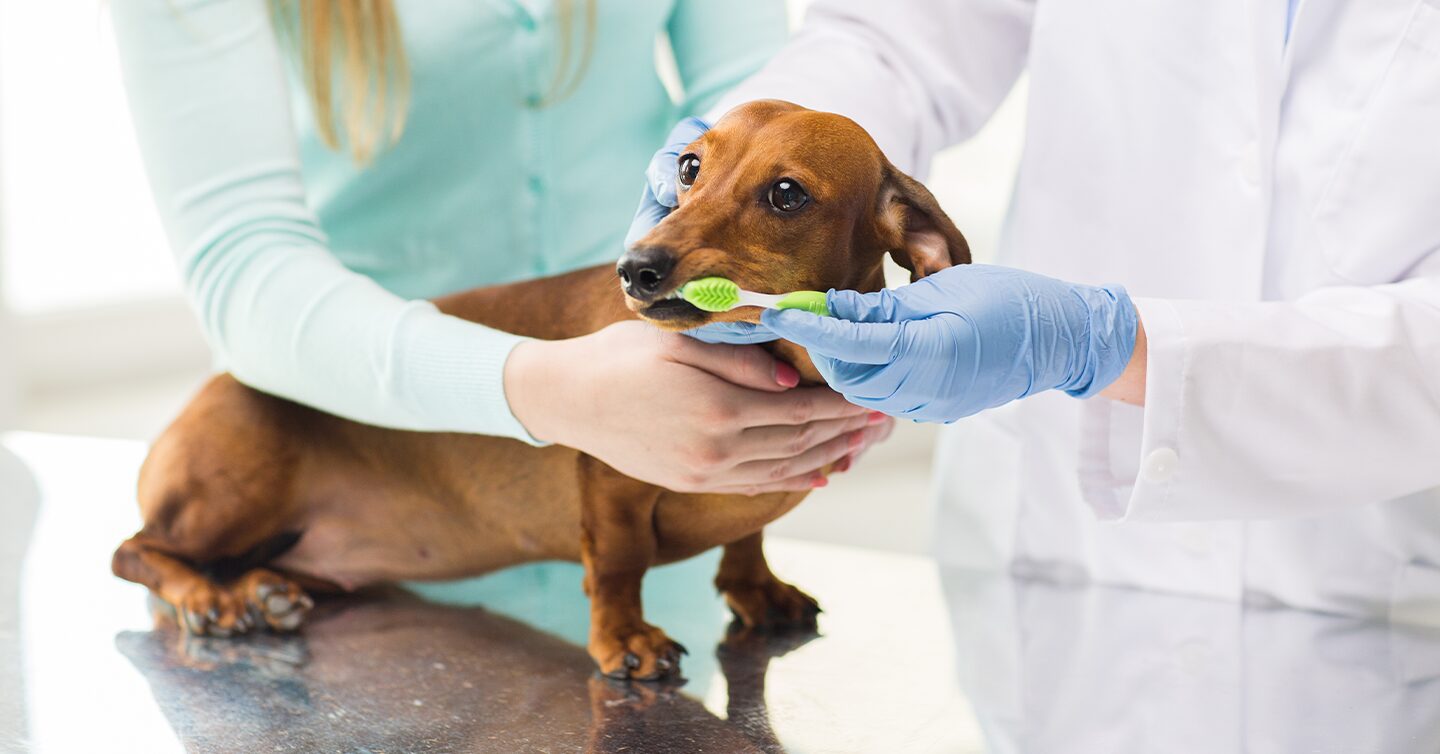Dental illness (and the vet bills that go along with it) are costly to treat, so finding pet insurance that includes dental coverage is a great choice. But not all pet insurance plans are created equal. There is significant variation in benefits, exclusions, and qualifying conditions for dental illness coverage.
To help you navigate the complicated world of pet dental illness coverage, we’re laying out the conditions and services that pet insurance plans may cover, the ones they may not, plus the limitations you need to know about.
Why do I need coverage for dental illnesses?
Dental disease (AKA periodontal or gum disease) is one of the most common illnesses seen in dogs and cats. An estimated 70% of cats and 80% of dogs develop dental disease by age three, but it often goes undetected by pet owners. Left untreated, dental disease can cause:
- Chronic pain
- Tooth loss
- Infections or abscesses
- Eroded gums
- Deciduous teeth
It can even lead to dangerous infections that spread to major organs, like the heart, lungs, liver, and kidneys. When the disease is discovered, treatment can be costly and time-consuming, especially if it’s diagnosed in the later stages.
Serious cases of gum disease or periodontal disease can wreak havoc on a pet’s mouth and body, eventually leading to an increased risk of heart, kidney, and liver disease. Between 2017 and 2020, the average claim cost for dogs with periodontal disease was $1,942 – just think of all the treats you could buy with that!
Given the serious nature of advanced periodontal disease, protecting your pet’s teeth is essential for their overall health and well-being. Considering the high price tag, coverage for diagnostics and treatments for dental illness is a vital part of your pet’s overall insurance coverage.
Tip: A regular tooth brushing schedule can help prevent periodontal disease. If you can’t brush your pet’s teeth daily, try to clean those teeth at least once a week!
Does pet insurance cover dental illnesses?
A pet insurance plan with extensive accident and illness coverage should cover dental illnesses.
Be mindful that pet insurance coverage doesn’t always include dental illness coverage. Many pet insurance plans do exclude dental illness coverage or have preventive care requirements you must meet before your pet can be covered. It pays to delve into the policies of the plans you are considering to fully understand what is included in their dental coverage.
With Pumpkin plans, we are proud to offer coverage for dental illnesses because we know it’s a necessity, not a nice-to-have. Dental illnesses can happen to any pet at any age, so having this coverage is crucial.
Does pet insurance cover dental cleanings?
Dental cleanings are a form of preventive care (also called wellness care). While regular cleanings are key for reducing dental health issues, pet accident & illness insurance plans aren’t designed to offer coverage for general oral health and hygiene upkeep.
Some insurance plans that offer dental illness coverage, including Pumpkin plans, don’t cover annual dental exams or cleanings unless they’re used to treat an illness, like gum disease.
This is where coverage can get confusing. Sometimes, a dental cleaning (usually preventive) will be prescribed as the treatment for an already-present dental illness. When it’s prescribed as a treatment for a covered condition, dental cleanings may be covered under your pet insurance plan.
For help paying for preventive care, some pet insurance providers offer a wellness plan or wellness package that can be used for dental services. Depending on the provider, you may be able to purchase this separately or as an add-on to your insurance plan.
Does pet insurance cover tooth extractions?
Your pet may need a tooth extraction for a variety of reasons, from periodontal disease to a dental injury from biting something they shouldn’t. Most pet insurances that offer dental illness coverage, including Pumpkin plans, will cover tooth extractions for an accident or illness.
Periodontal disease is the most common illness that leads to tooth extractions, but a fractured tooth, tooth decay, or an unerupted tooth (when a tooth is stuck below the gum line) are other common conditions that call for this surgery.
Without insurance, vet bills for tooth extraction can be costly. The procedure requires cleaning, x-rays, general anesthesia, bloodwork, IV fluids, and post-surgical hospitalization, all of which add up to about $500 to $900 per tooth, making coverage critical for pet owners.
What other dental conditions and services does pet insurance cover?
Some pet insurance plans will cover dental treatments for illnesses and accidents. This can include a wide range of conditions your pet might experience, including:
- Gingivitis
- Stomatitis
- Periodontal disease
- Tooth abscesses
- Oral growths and tumors
- Fractured jaw or tooth
It may also cover a range of veterinary services and treatments for covered conditions, like:
- Tooth extractions
- X-rays
- Scans
- Treatments
- Prescription medicine
Pumpkin Pet Insurance plans cover treatments for dental illnesses and tooth extractions only for dental accidents.
Which dental services will pet insurance not cover?
Here’s a list of elective or cosmetic dental procedures and services that pet insurance plans usually won’t cover:
- Caps
- Crowns
- Crown amputations
- Fillings
- Implants
- Scaling and/or planing
- Root canals
In addition to these services and procedures, most preventive dental services are not eligible for claim reimbursement with a pet insurance plan. Plans likely won’t cover medications, tools, or treats related to routine oral hygiene, like pet toothbrushes and toothpaste, dental chews, or dental supplements.
What’s the difference between preventive dental care and treatment for dental illnesses?
Dental preventive care refers to services you perform or pay for that are intended to help prevent dental illnesses from developing. This can include getting regular dental cleanings or purchasing tooth-friendly snacks and toys.
Dental illness treatment refers to diagnostics and treatments intended to treat a dental illness.
Are there any requirements, conditions, or limits of dental illness coverage I should know about?
Yes, there are a few. If your pet has a dental illness that is a pre-existing condition, this would not be covered by most pet insurance policies. Likewise, if a dental illness occurred or showed symptoms during a waiting period, this may not be covered.
Before covering your pet’s dental treatments for illnesses, some pet insurance plans require you to bring your pet in for an annual dental exam and dental cleaning – and pay for it out of pocket. Additionally, they might only reimburse you up to a certain amount (like $1,000) per year or condition.
Luckily, Pumpkin insurance plans don’t require you to bring your pet in for an annual teeth cleaning. Pumpkin plans also don’t have a separate annual limit just for dental illnesses, so you won’t encounter extra surprises when it’s time to take your pet to the vet. If your pet needs expensive surgery for gum disease, Pumpkin plans will reimburse you for eligible expenses up to your plan’s annual limit.
FAQS
Does pet dental insurance exist by itself?
You likely won’t find pet dental insurance as a separate form of insurance from a pet accident & illness insurance plan. That’s why it’s extra important to make sure dental illness coverage is included in your pet insurance plan.
You may be able to find a wellness plan that includes routine dental care as a benefit, but this won’t help you pay for costs related to dental illnesses or accidents.
Which is the best pet insurance plan for dental illness coverage?
A great pet insurance plan will include dental illness coverage in its policy. That said, dental coverage differs greatly from provider to provider. The best insurance plan for you and your pet will depend on your individual needs, budget, and coverage requirements.
For assistance comparing different pet insurance providers, we have a helpful comparison page here. This page offers an in-depth look at plans from providers like AKC, Embrace, Trupanion, Figo, and Healthy Paws.
What measures can I take to protect my pet’s dental health?
Giving your pet’s teeth regular attention is an immense help when it comes to keeping dental issues at bay. While brushing your dog’s teeth can be a handful, and wrangling your cat for a cleaning might be a workout, it’s so worth it.
We created a full guide to caring for your pet’s dental health, but we’ll give you the speedy version here:
- Create a regular at-home teeth cleaning schedule
- Schedule regular professional dental checkups and cleanings
- Ensure your pet eats a balanced, healthy diet
- Find dental-friendly toys and treats
The bottom line
Dental problems are no fun for you or your pet, and dental illness coverage can save you thousands of dollars over your pet’s lifetime. However, it’s important to keep in mind that not all insurance plans are created equal – and neither is all dental illness coverage. Do your homework and find out if the pet insurance plan you’re considering offers this coverage – and don’t forget to read the fine print! Next, take your research a step further and see what specific benefits the plan offers, as well as exclusions, requirements, and limits you might have to take into consideration.
Your best friend deserves only the best pet dental care, and pet insurance can help make that possible. Find out more ways Pumpkin plans can help keep your four-legged friends healthy and happy!
DISCLOSURE




